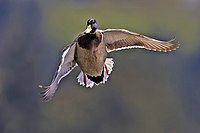Confirmed bird flu death in Nigeria
Wednesday, January 31, 2007
A woman, one of three people who recently died of flu like symptoms, in Lagos, Nigeria, has tested positive for the H5N1 strain of Avian influenza.
It is the first bird flu in Nigeria since the strain arrived in Nigeria a year ago. H5N1 was confirmed in blood samples tested in Rome and London from the three recent deaths.
The Food and Agriculture Organization of the United Nations stated that while the threat from avian flu has decreased from last year, there still remains flare-ups around the world, urging countries to "remain vigilant and fully cooperate with international organizations".
Avian influenza
editBird flu is spread by wild birds for whom the virus is a stomach disease and, generally, not fatal.
Although the disease has killed 164 people, it has only been out of 269 cases, this gives the disease around a 60% fatality rate compared to the 1918 'Spanish flu' pandemic which had a mortality rate of around 5%.
Structure
editThe outer coat of the virus particle is characterised by two types of glyco-proteins, neurominidase and haemagglutinin, both of which interact with sialic acid.

Haemagglutinin has sixteen forms, H1 to H16, and binds to sialic acid on the target cell, facilitating the entry of the virus.
Neurominidase is found in nine forms, N1 to N9, this protein allows the progeny viri to escape the infected cell by cleaving sialic acid.
Anti-viral drugs
editThe two main drugs against bird flu currently on the market, Tamiflu® and Relenza®, both target the sialic acid binding pocket of neurominidase. Neither of these drugs will cure the disease, but will stop its spread through the body. As such they have to be administered within 48 hours of symptoms appearing. In all 9 sub types of neurominidase, the structure of the target area for the drugs is the same. There is also a flu vaccine but the current flu vaccine does not protect against H5N1.
Catching the disease
editHuman to human transmission is very rare, at the moment bird flu can only be caught from prolonged exposure to infected birds, specifically their droppings from which the bird flu virus has been crystallized and parts of the structure solved.
Unlike diseases such as smallpox and measles, for which their are effectively protecting vaccines, the flu virus constantly mutates. Each year the virus is slightly different from the last, this is the genetic drift of the virus - small point mutations on the surface, causing an evasion of our immune system. Many of the problems arise when there is a major shift of the surface proteins, for instance when a different subtype appears, such as H5.
There are three strains of human influenza circulating around the globe; H1N1 first isolated in 1933, H2N2 first isolated in 1957 and H3N2 first isolated in 1968. Other than humans; pigs, seals and horses have various strains of influenza, however only wild birds have all the known subtypes of haemagglutinin and neurominidase. Of the 144 combinations of N(1-9) and H(1-16) we have had three.
Sources
edit- "First bird flu death in Nigeria" — BBC News Online, January 31, 2007
- World Organization for Animal Health. "New bird flu outbreaks require strong vigilance" — Food and Agriculture Organization, January 23, 2007
External references
edit- Structure of catalytic sites in influenza neurominidase, Colman, Varghese, Laver Nature; 303 41-44 (1983)
- Relenza: 'Rational design of potent sialidase-based inhibitors of influenza virus replication' Itzstein et al, Nature 363 (1993)
- Tamiflu: 'Influenza neurominidase inhibitors possessing a novel hydrophobic interaction in the enzyme active site: Design, synthesis and structural analysis of carbocyclic sialic acid analogues with potent anti-influenza activity' Kim et al, J.Am.Chem Soc 119 681-690 (1997)
- Controlling influenza by inhibiting the virus's neurominidase' Garman and Laver, Current Drug Targets 2004, 5, 119-136
External links
edit- World Health Organization
- World Organization for Animal Health
- Food and Agriculture Organization of the United Nations
